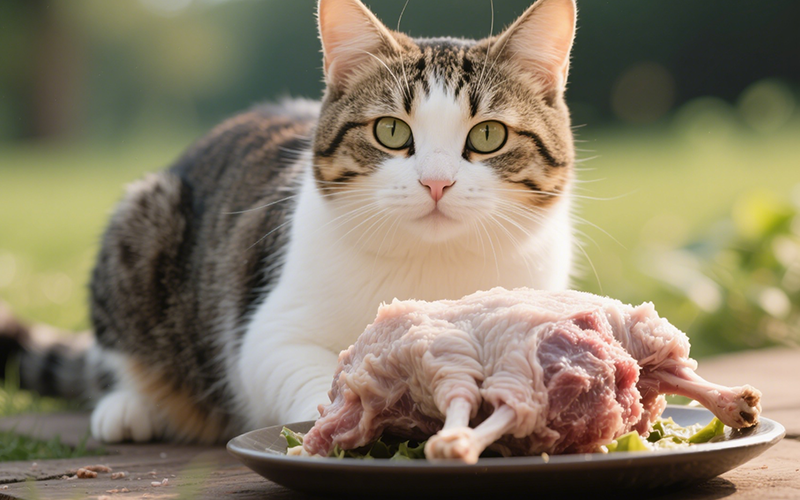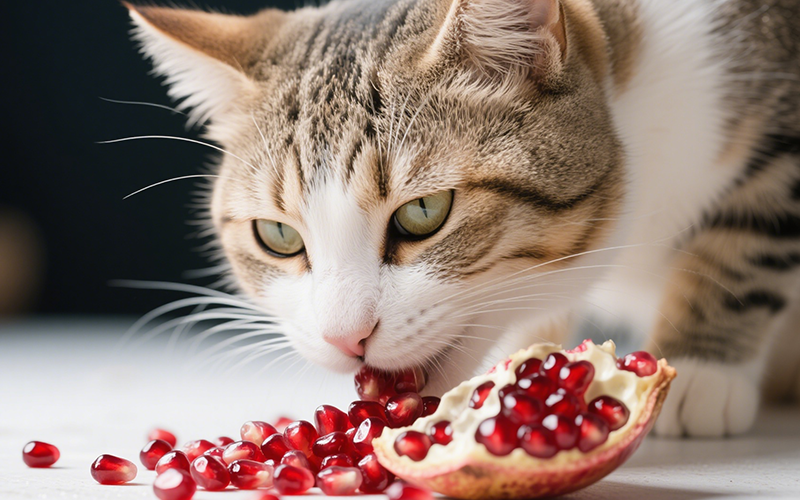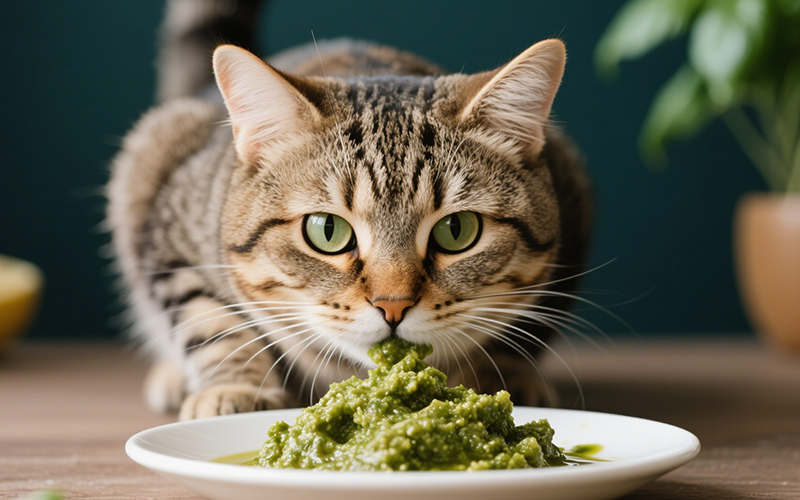Lamb on the Menu? A Vet-Reviewed Guide to Safely Feeding Lamb to Your Cat
- 11 Apr 2025 16:14
As devoted cat parents, exploring diverse and nutritious options for our feline companions is natural. We know cats are obligate carnivores, thriving on meat-based diets. This often leads to questions about specific types of meat, and a common one is: can cats eat lamb? Lamb, often associated with special occasions or gourmet meals for humans, might seem like a luxurious treat for our pets. But is it safe, beneficial, and appropriate for their unique dietary needs?
The simple answer is yes, cats can generally eat lamb, provided it's prepared correctly and offered in moderation. Lamb is a red meat rich in nutrients that align well with a cat's carnivorous requirements. However, like any food outside their regular formulated diet, there are crucial considerations regarding preparation, fat content, potential risks, and how it fits into a balanced nutritional plan. This comprehensive guide delves into everything you need to know about feeding lamb to cats, ensuring you make informed choices for your furry friend's health and well-being, backed by veterinary insights and nutritional science.

Lamb & Feline Nutrition: A Natural Fit?
Understanding why lamb can be a suitable food for cats starts with understanding their fundamental biology. Cats are obligate carnivores. This means their bodies are specifically designed to derive essential nutrients primarily, if not exclusively, from animal tissue. Their digestive systems are short and efficient at processing protein and fat, while their ability to digest carbohydrates is limited.
How does lamb fit into this picture?
High Protein Content: Lamb is an excellent source of high-quality animal protein, crucial for cats to maintain lean muscle mass, support enzyme function, produce antibodies, and fuel their energy needs.
Source of Animal Fat: It provides essential fatty acids, which are vital for skin and coat health, hormone production, absorption of fat-soluble vitamins (A, D, E, K), and providing a concentrated source of energy.
Essential Nutrients: Lamb meat contains vital nutrients that cats require, including Taurine (though levels can vary, crucial for heart health, vision, and reproduction), Vitamin B12 (for neurological function and cell growth), Niacin, Vitamin B6, Iron (for oxygen transport in blood), Zinc (immune function, skin health), and Selenium (antioxidant properties).
Compared to plant-based ingredients or diets high in carbohydrates, plain lamb aligns much more closely with the ancestral and biological dietary needs of a cat. It provides the building blocks they are naturally equipped to utilize efficiently.
The Benefits of Feeding Lamb to Cats
When prepared safely and offered appropriately, incorporating lamb into your cat's diet can offer several advantages:
High-Quality Protein Source
As mentioned, lamb is packed with protein. This is fundamental for cats throughout their lives, supporting growth in kittens, muscle maintenance in adults, and helping senior cats combat age-related muscle loss (sarcopenia). High-quality protein is easily digestible and provides the essential amino acids cats cannot synthesize themselves.
Essential Fatty Acids
Lamb contains beneficial fatty acids, including omega-3 and omega-6. These fats contribute significantly to:
Healthy Skin: Reducing dryness and itchiness.
Glossy Coat: Promoting a shiny, healthy appearance.
Inflammation Control: Omega-3s, in particular, have anti-inflammatory properties that can benefit cats with certain health conditions.
The specific fat profile can vary depending on the cut of lamb and the animal's diet.
Rich in Vitamins and Minerals
Lamb meat is a powerhouse of essential micronutrients vital for feline health:
B Vitamins (B12, Niacin, B6, Riboflavin): Crucial for energy metabolism, nervous system function, red blood cell production, and enzyme function.
Zinc: Essential for immune system health, wound healing, cell division, and maintaining healthy skin and coat.
Iron (Heme Iron): Lamb provides heme iron, a form highly bioavailable to carnivores, necessary for forming hemoglobin to carry oxygen in the blood. Prevents anemia.
Selenium: Acts as a powerful antioxidant, protecting cells from damage and supporting thyroid function.
Phosphorus: Works with calcium for strong bones and teeth.
Palatability and Food Motivation
Many cats find the taste and aroma of lamb highly appealing. This can be particularly beneficial for:
Picky Eaters: Offering small amounts of plain cooked lamb might entice cats with finicky appetites to eat.
Underweight Cats or Seniors: The calorie density and palatability can help encourage food intake in cats needing to gain weight or those with decreased appetite due to age or illness (always under veterinary guidance).
Novel Protein Potential
Food allergies and sensitivities in cats often develop towards proteins they are frequently exposed to, such as chicken, beef, or fish. Lamb is considered a 'novel' protein for many cats, meaning they likely haven't encountered it before. This makes it a potential candidate for:
Elimination Diets: Vets may use lamb as part of a diet trial to diagnose food allergies.
Cats with Known Allergies: If a cat is allergic to more common proteins, a lamb-based diet (commercial or vet-formulated) might be a suitable alternative. **It's crucial to consult your vet before using lamb for allergy management.**
Potential Risks and How to Avoid Them When Feeding Lamb
While lamb offers benefits, it's not without potential risks if not handled and prepared correctly. Awareness of these dangers is key to safely answering "can cats eat lamb?".
Fat Content and Pancreatitis
Lamb can be high in fat, particularly certain cuts. While cats need fat, excessive amounts, especially consumed suddenly, can lead to:
Gastrointestinal Upset: Vomiting and diarrhea are common reactions to overly fatty foods.
Pancreatitis: A serious and painful inflammation of the pancreas, which can be triggered by high-fat meals. Cooked fat is often harder for pets to digest and poses a higher risk.
Avoidance Strategy: Choose lean cuts of lamb (like loin or leg, well-trimmed). Remove visible fat before cooking. Feed only small quantities. Never feed greasy table scraps or cooked lamb fat to cats.
Seasoning and Additives
Lamb prepared for human consumption is often cooked with ingredients toxic to cats:
Onions, Garlic, Chives: All members of the Allium family are highly toxic, damaging red blood cells and causing anemia.
Salt: Excess salt can lead to sodium ion poisoning.
Spices, Sauces, Marinades: Can contain various harmful ingredients and cause stomach upset.
Avoidance Strategy: Only ever feed your cat PLAIN, unseasoned lamb. If sharing from your meal is the intention, set aside a small portion to cook separately without any additives.
The Raw vs. Cooked Debate
How you prepare the lamb matters significantly.
Risks of Raw Lamb for Cats: Feeding raw meat carries inherent risks:
Bacterial Contamination: Salmonella, E. coli, Listeria can be present, posing a risk to both the cat and the humans handling the meat.
Parasites: Toxoplasma gondii and other parasites can be transmitted through raw meat.
While some proponents advocate for raw diets, the risks are significant and require meticulous sourcing, handling, and often, vet consultation. Freezing meat for a specific duration may reduce some parasite risks but not bacterial ones.
Cooked Lamb for Cats: Generally considered the safer option:
Reduces Pathogen Risk: Thorough cooking kills most harmful bacteria and parasites.
Preparation: Must be cooked plainly (boiled, steamed, baked) without oils, fats, or seasonings. Ensure it's cooked through to a safe internal temperature.
Avoidance Strategy: For most pet owners, feeding plain, thoroughly cooked lamb is the safest approach. If considering raw feeding, extensive research and a discussion with a veterinarian experienced in feline nutrition are essential.
Bone Hazards
Never give cooked bones of any kind to cats. Cooked lamb bones for cats become brittle and can easily splinter.
Choking Hazard: Bone fragments can lodge in the throat.
Internal Damage: Splinters can perforate the mouth, esophagus, stomach, or intestines, leading to life-threatening internal bleeding or infection.
Intestinal Blockage: Bone pieces can obstruct the digestive tract.
Raw meaty bones are sometimes recommended by raw feeding advocates *under very specific conditions* (appropriate size, type, non-weight bearing bones, strict supervision), but they still carry risks of tooth fracture and choking/blockage. For the average cat owner, avoiding bones altogether is the safest policy.
Avoidance Strategy: ALWAYS remove all bones from lamb before feeding it to your cat, whether raw or cooked.
Portion Control and Obesity
Lamb is nutrient-dense and calorie-dense. Feeding too much, even of plain cooked lamb, can contribute to weight gain and obesity, which predisposes cats to numerous health problems like diabetes, arthritis, and heart disease.
Avoidance Strategy: Treat lamb as a treat or supplement, not a primary food source (unless using a balanced commercial or vet-formulated lamb diet). Treats should constitute no more than 10% of your cat's total daily caloric intake. Use small, bite-sized pieces.
How to Safely Prepare Lamb for Your Cat
If you decide to offer lamb, following these preparation steps is crucial for safety:
1. Choose Lean Cuts: Opt for leaner cuts like lamb loin or leg. Trim away as much visible fat as possible. 2. Cook Thoroughly (Recommended Method): * Boil, steam, or bake the lamb until fully cooked. Do NOT add salt, oil, butter, garlic, onions, spices, or any other seasonings. * Ensure there are no pink parts remaining (check internal temperature if possible, aiming for at least 160°F or 71°C). * Allow the lamb to cool completely. 3. NO Bones: Meticulously remove ALL bones before serving. Double-check for small fragments. 4. Cut into Small Pieces: Dice the cooked lamb into tiny, manageable, bite-sized pieces appropriate for your cat's size to prevent choking. 5. Serve Plain: Offer the plain lamb pieces directly to your cat. Do not mix with rich gravies or sauces. 6. Raw Preparation (Use Extreme Caution & Vet Guidance): * If choosing raw, source human-grade lamb from a highly reputable supplier. * Freeze the meat at appropriate temperatures (-4°F/-20°C or lower) for a specific duration (e.g., several days to weeks, consult guidelines) to potentially reduce parasite risk (does not kill bacteria). * Thaw safely in the refrigerator. * Practice strict hygiene: separate cutting boards, utensils, wash hands and surfaces thoroughly. * Remove bones, cut into small pieces. * **Strongly recommended to discuss with your vet before feeding any raw meat.** 7. Introduce Slowly: Offer only a tiny amount the first time to see how your cat tolerates it. Watch for any signs of digestive upset (vomiting, diarrhea) over the next 24-48 hours.
Following these steps significantly minimizes the risks associated with feeding lamb to cats.
Integrating Lamb into a Balanced Feline Diet
It's vital to remember that plain lamb, while nutritious, is not a complete and balanced diet on its own. Commercial cat foods are specifically formulated with the precise balance of proteins, fats, vitamins, minerals (like calcium, which is low in plain meat), and taurine that cats need.
As a Treat: Small pieces of cooked lamb make an excellent high-value treat. Remember the 10% rule: treats should not exceed 10% of your cat's daily calories to avoid unbalancing their diet and causing weight gain.
As a Food Topper: A tiny amount shredded or diced over their regular food can enhance palatability for picky eaters.
Part of a Vet-Formulated Diet: If using lamb as a primary protein due to allergies, it must be part of a balanced recipe formulated by a veterinary nutritionist to avoid deficiencies. Do not attempt to create a homemade diet based solely on lamb without expert guidance.
Always ensure your cat has access to fresh water, especially if adding new foods to their diet.
Table Summary: Lamb for Cats - Key Considerations
| Aspect | Safe Practice / Benefit | Risk / Caution |
| Overall Safety | Yes, cats can eat lamb when prepared correctly. | Requires careful preparation and moderation. |
| Nutritional Value | High-quality protein, essential fats, vitamins (B-group), minerals (Iron, Zinc). Good for obligate carnivores. | Not a complete diet alone; lacks balanced calcium/phosphorus, potentially lower taurine than formulated foods. |
| Preparation | Best served plain, thoroughly cooked lamb for cats (boiled, steamed, baked). Cut small. | Avoid ALL seasonings (salt, garlic, onion), oils, sauces. |
| Lamb Fat | Source of energy and essential fatty acids in moderation. | Trim excess fat. High fat can cause GI upset or pancreatitis. Avoid feeding cooked lamb fat to cats. |
| Lamb Bones | None. | NEVER feed cooked lamb bones to cats (choking/splintering risk). Raw bones also carry risks and require extreme caution/supervision. Best to avoid. |
| Raw Lamb | May appeal to some raw feeding philosophies (requires vet consult). | High risk of bacteria (Salmonella, E.coli) and parasites. Requires stringent sourcing and handling. Discuss raw lamb for cats with vet. |
| Portion Size | Small amounts as treats (max 10% daily calories). | Excess can lead to obesity and unbalance the diet. |
| Allergies | Can be a good novel protein for cats with allergies to common meats (vet guidance needed). | Cats can develop allergies to any protein, including lamb. Introduce slowly. |
Expert Veterinary Opinion on Lamb for Cats
Veterinarians generally agree that plain, cooked, boneless lamb is safe for cats in moderation and can be a nutritious treat or supplement. They emphasize the importance of:
Proper Preparation: No seasonings, thorough cooking, no bones, lean cuts.
Moderation: Keeping lamb portions small to avoid digestive upset and maintain dietary balance.
Avoiding Raw Risks: Most vets advise against feeding raw meat due to pathogen risks unless the owner is fully educated, committed to safety protocols, and does so under veterinary supervision.
Consultation: Discussing any dietary changes, including adding lamb, with a vet is recommended, especially for cats with health conditions (like kidney disease, pancreatitis history, or allergies) or if considering lamb as a primary protein source.
The consensus is clear: is lamb safe for cats? Yes, under the right conditions, but caution and adherence to safe preparation guidelines are paramount.
Unsure About Your Cat's Diet? PettureX Can Help!
Navigating feline nutrition and knowing what's truly safe and beneficial can feel overwhelming. Whether you're wondering "can cats eat lamb?" or concerned about a potential reaction to a new food, having reliable support is crucial.
We recommend exploring the PettureX App – a modern tool designed for proactive pet parents:
AI-Powered Vet Consultation (24/7): Got a late-night question about feeding lamb? Wondering if a symptom like vomiting after a new treat is serious? Get quick AI-driven veterinary advice and guidance on next steps, anytime.
Image Recognition for Health Insights: While it won't analyze the lamb itself, PettureX's image recognition can help identify potential skin issues (which could indicate allergies) or other visible health concerns you might notice in your cat.
Quick Solutions & Information: Access a wealth of pet care information and get fast answers to common questions, helping you make informed decisions about diet, health, and wellness.
Breed Identification: Curious about your cat's breed? Snap a picture!
PettureX offers convenient support for your pet care journey, acting as a valuable resource alongside your regular veterinary care. Download it to have pet health information right at your fingertips!
Conclusion: Lamb Can Be a Safe and Savory Treat
So, can cats eat lamb? Absolutely. When selected carefully (lean cuts), prepared safely (plain, thoroughly cooked, boneless), and offered in moderation, lamb can be a highly palatable and nutritious addition to your cat's diet, primarily as a treat or supplement.
It aligns well with their needs as obligate carnivores, providing high-quality protein and essential nutrients. However, the potential risks associated with fat content, seasonings, bones, and improper preparation (especially raw) cannot be ignored. Always prioritize safety by following the preparation guidelines meticulously.
Remember that lamb should complement, not replace, a complete and balanced commercial or vet-formulated feline diet. If you have any doubts or specific concerns about feeding lamb to your cat, especially if they have underlying health issues, a consultation with your veterinarian is always the best course of action to ensure your feline friend enjoys this meaty treat safely.
Related

Pomegranate Peril: Can Cats Eat the Seeds Safely? A Vet-Reviewed Guide
- 25 Apr 2025
Prickly Problem: Can Cats Eat Pineapple Leaves Safely? A Vet-Reviewed Risk Analysis
- 25 Apr 2025
The Prickly Truth: Can Cats Eat Pine Needles Safely? A Guide for Concerned Owners
- 24 Apr 2025
Pesto & Paws: A Dangerous Mix? Can Cats Eat Pesto Safely?
- 24 Apr 2025
Persimmons and Paws: Can Cats Safely Eat This Autumn Fruit? A Vet-Reviewed Guide
- 23 Apr 2025
Nutritional Yeast for Cats: Savory Sprinkle or Health Hazard? A Vet-Reviewed Guide
- 23 Apr 2025
Marshmallows and Cats: A Puffy Problem? Why Vets Say No to This Sugary Snack
- 22 Apr 2025
Kefir for Kitties? A Veterinarian-Reviewed Guide to Safety, Benefits & Risks
- 22 Apr 2025
The Burning Question: Can Cats Eat Jalapenos? A Comprehensive Safety Guide
- 21 Apr 2025
Cool Temptation: Can Cats Eat Ice Cream Safely? The Vet-Backed Truth
- 21 Apr 2025
